Impact of IYCF Education on Infant Mortality in Rural Nepal Analysis
VerifiedAdded on 2020/03/16
|18
|4550
|50
Report
AI Summary
This report investigates the impact of Infant and Young Child Feeding (IYCF) education on infant mortality in rural Nepal. It explores the critical role of IYCF practices, including breastfeeding and complementary feeding, in child health and development. The study aims to evaluate the effectiveness of IYCF education in reducing infant mortality rates, assessing behavioral changes among mothers, families, and healthcare professionals. The research addresses key questions concerning the implementation, cost-effectiveness, and importance of IYCF education programs. The report provides background information on the high child mortality and under-nutrition rates in Nepal, emphasizing the need for interventions to improve nutrition and promote breastfeeding practices. The proposed action plan outlines strategies to increase access to information, improve IYCF behavior and awareness, establish a supportive policy environment, and enhance capacity building among healthcare professionals, ultimately aiming to decrease infant mortality rates and promote exclusive breastfeeding. The report highlights the economic benefits of IYCF education and the role of healthcare workers in ensuring effective practices, supported by ethical guidelines and funding from international organizations.
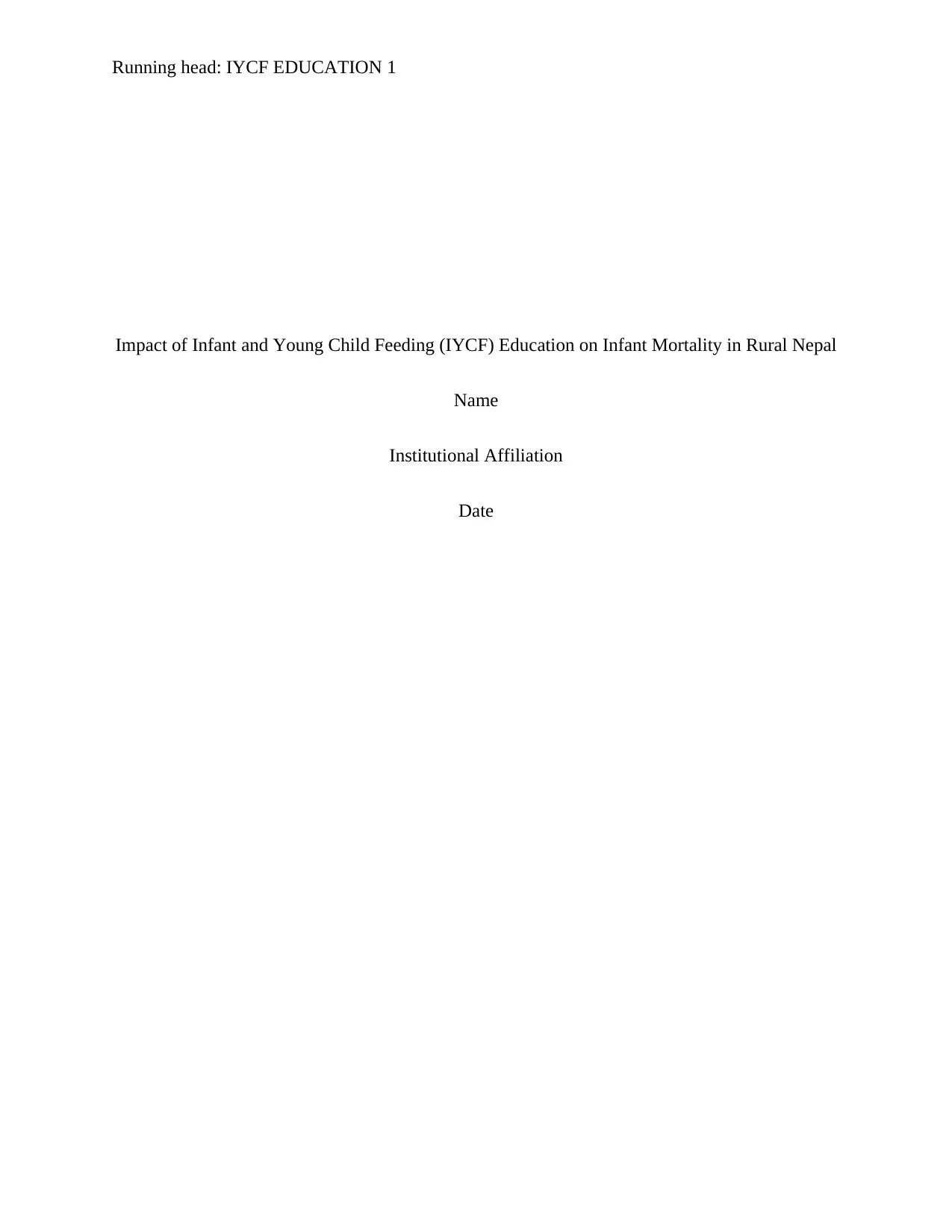
Running head: IYCF EDUCATION 1
Impact of Infant and Young Child Feeding (IYCF) Education on Infant Mortality in Rural Nepal
Name
Institutional Affiliation
Date
Impact of Infant and Young Child Feeding (IYCF) Education on Infant Mortality in Rural Nepal
Name
Institutional Affiliation
Date
Paraphrase This Document
Need a fresh take? Get an instant paraphrase of this document with our AI Paraphraser
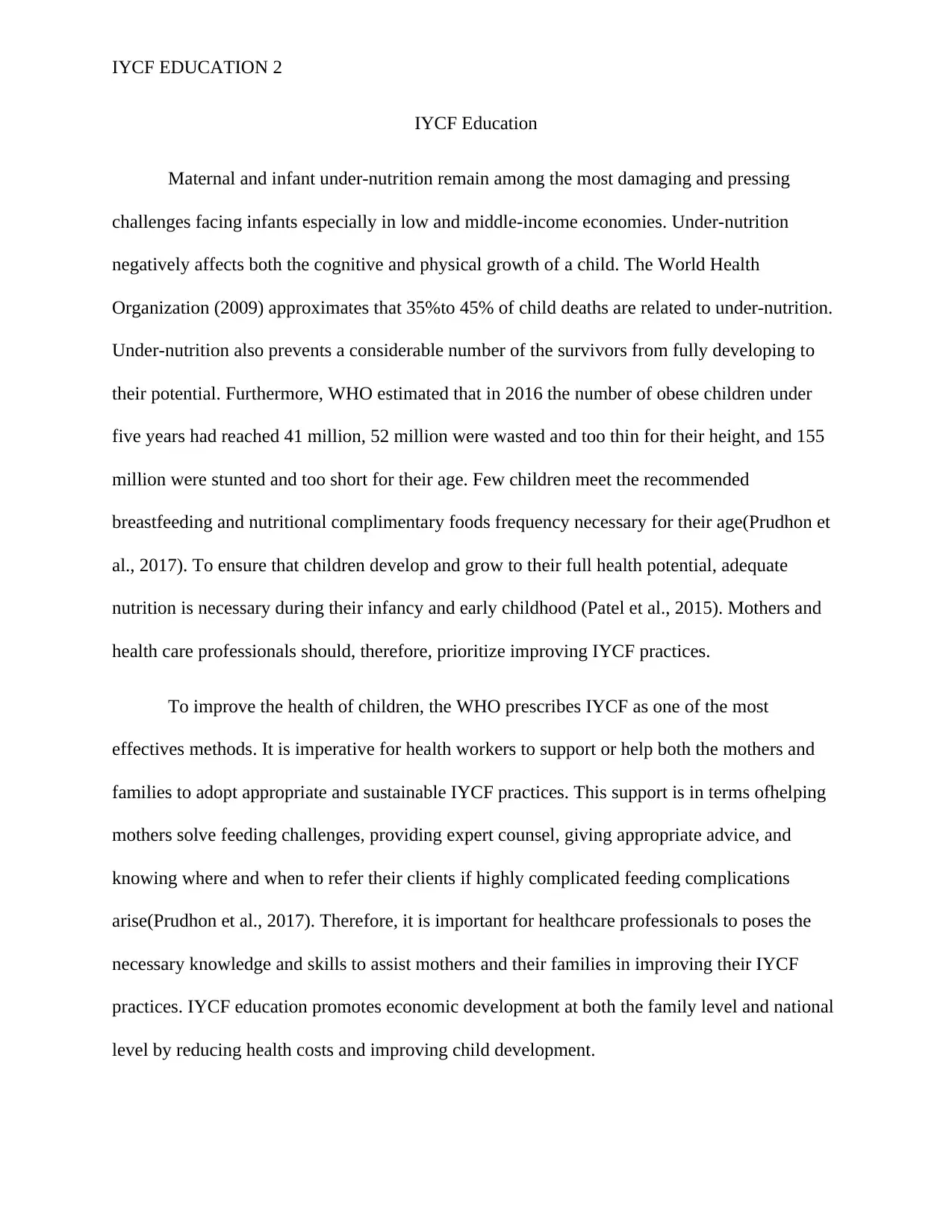
IYCF EDUCATION 2
IYCF Education
Maternal and infant under-nutrition remain among the most damaging and pressing
challenges facing infants especially in low and middle-income economies. Under-nutrition
negatively affects both the cognitive and physical growth of a child. The World Health
Organization (2009) approximates that 35%to 45% of child deaths are related to under-nutrition.
Under-nutrition also prevents a considerable number of the survivors from fully developing to
their potential. Furthermore, WHO estimated that in 2016 the number of obese children under
five years had reached 41 million, 52 million were wasted and too thin for their height, and 155
million were stunted and too short for their age. Few children meet the recommended
breastfeeding and nutritional complimentary foods frequency necessary for their age(Prudhon et
al., 2017). To ensure that children develop and grow to their full health potential, adequate
nutrition is necessary during their infancy and early childhood (Patel et al., 2015). Mothers and
health care professionals should, therefore, prioritize improving IYCF practices.
To improve the health of children, the WHO prescribes IYCF as one of the most
effectives methods. It is imperative for health workers to support or help both the mothers and
families to adopt appropriate and sustainable IYCF practices. This support is in terms ofhelping
mothers solve feeding challenges, providing expert counsel, giving appropriate advice, and
knowing where and when to refer their clients if highly complicated feeding complications
arise(Prudhon et al., 2017). Therefore, it is important for healthcare professionals to poses the
necessary knowledge and skills to assist mothers and their families in improving their IYCF
practices. IYCF education promotes economic development at both the family level and national
level by reducing health costs and improving child development.
IYCF Education
Maternal and infant under-nutrition remain among the most damaging and pressing
challenges facing infants especially in low and middle-income economies. Under-nutrition
negatively affects both the cognitive and physical growth of a child. The World Health
Organization (2009) approximates that 35%to 45% of child deaths are related to under-nutrition.
Under-nutrition also prevents a considerable number of the survivors from fully developing to
their potential. Furthermore, WHO estimated that in 2016 the number of obese children under
five years had reached 41 million, 52 million were wasted and too thin for their height, and 155
million were stunted and too short for their age. Few children meet the recommended
breastfeeding and nutritional complimentary foods frequency necessary for their age(Prudhon et
al., 2017). To ensure that children develop and grow to their full health potential, adequate
nutrition is necessary during their infancy and early childhood (Patel et al., 2015). Mothers and
health care professionals should, therefore, prioritize improving IYCF practices.
To improve the health of children, the WHO prescribes IYCF as one of the most
effectives methods. It is imperative for health workers to support or help both the mothers and
families to adopt appropriate and sustainable IYCF practices. This support is in terms ofhelping
mothers solve feeding challenges, providing expert counsel, giving appropriate advice, and
knowing where and when to refer their clients if highly complicated feeding complications
arise(Prudhon et al., 2017). Therefore, it is important for healthcare professionals to poses the
necessary knowledge and skills to assist mothers and their families in improving their IYCF
practices. IYCF education promotes economic development at both the family level and national
level by reducing health costs and improving child development.
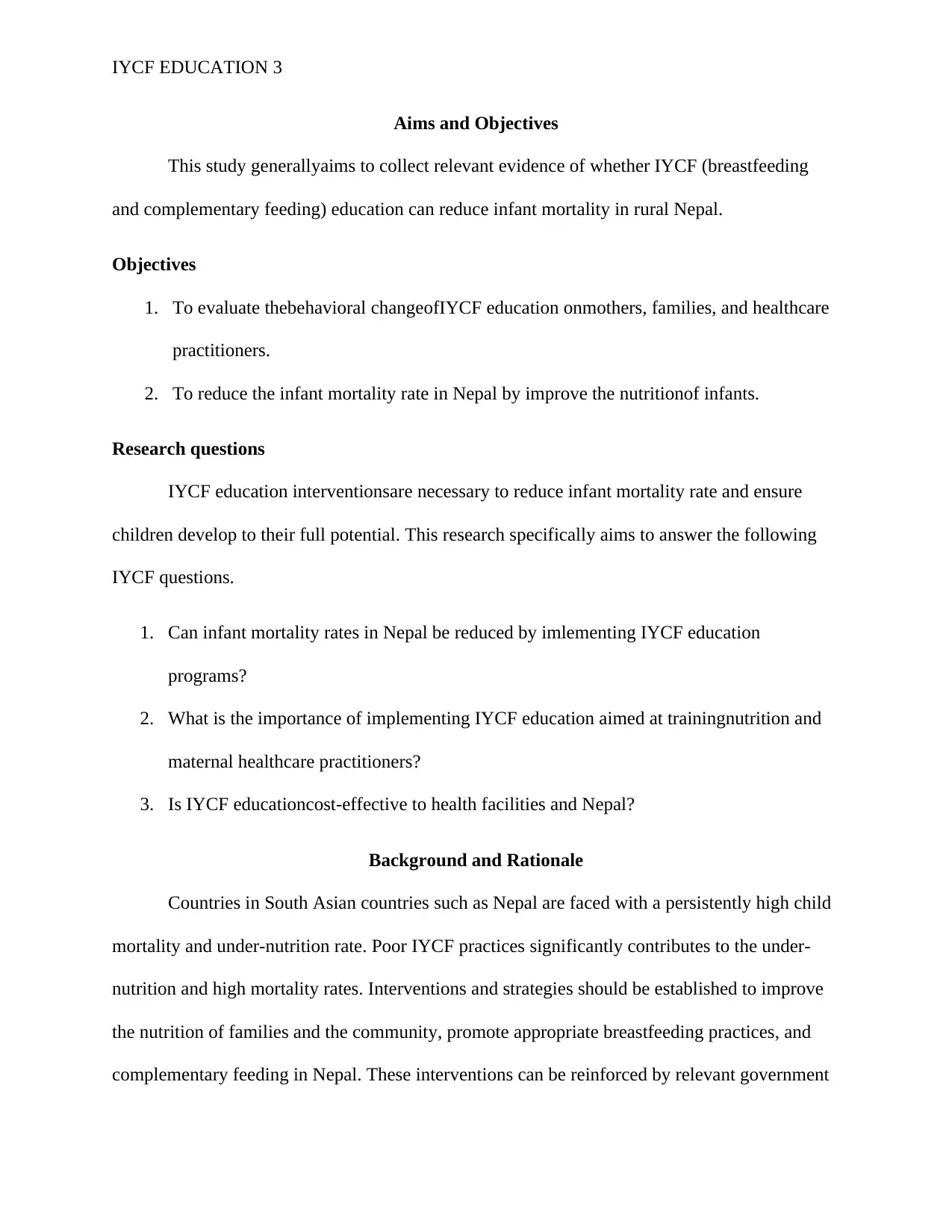
IYCF EDUCATION 3
Aims and Objectives
This study generallyaims to collect relevant evidence of whether IYCF (breastfeeding
and complementary feeding) education can reduce infant mortality in rural Nepal.
Objectives
1. To evaluate thebehavioral changeofIYCF education onmothers, families, and healthcare
practitioners.
2. To reduce the infant mortality rate in Nepal by improve the nutritionof infants.
Research questions
IYCF education interventionsare necessary to reduce infant mortality rate and ensure
children develop to their full potential. This research specifically aims to answer the following
IYCF questions.
1. Can infant mortality rates in Nepal be reduced by imlementing IYCF education
programs?
2. What is the importance of implementing IYCF education aimed at trainingnutrition and
maternal healthcare practitioners?
3. Is IYCF educationcost-effective to health facilities and Nepal?
Background and Rationale
Countries in South Asian countries such as Nepal are faced with a persistently high child
mortality and under-nutrition rate. Poor IYCF practices significantly contributes to the under-
nutrition and high mortality rates. Interventions and strategies should be established to improve
the nutrition of families and the community, promote appropriate breastfeeding practices, and
complementary feeding in Nepal. These interventions can be reinforced by relevant government
Aims and Objectives
This study generallyaims to collect relevant evidence of whether IYCF (breastfeeding
and complementary feeding) education can reduce infant mortality in rural Nepal.
Objectives
1. To evaluate thebehavioral changeofIYCF education onmothers, families, and healthcare
practitioners.
2. To reduce the infant mortality rate in Nepal by improve the nutritionof infants.
Research questions
IYCF education interventionsare necessary to reduce infant mortality rate and ensure
children develop to their full potential. This research specifically aims to answer the following
IYCF questions.
1. Can infant mortality rates in Nepal be reduced by imlementing IYCF education
programs?
2. What is the importance of implementing IYCF education aimed at trainingnutrition and
maternal healthcare practitioners?
3. Is IYCF educationcost-effective to health facilities and Nepal?
Background and Rationale
Countries in South Asian countries such as Nepal are faced with a persistently high child
mortality and under-nutrition rate. Poor IYCF practices significantly contributes to the under-
nutrition and high mortality rates. Interventions and strategies should be established to improve
the nutrition of families and the community, promote appropriate breastfeeding practices, and
complementary feeding in Nepal. These interventions can be reinforced by relevant government
⊘ This is a preview!⊘
Do you want full access?
Subscribe today to unlock all pages.

Trusted by 1+ million students worldwide
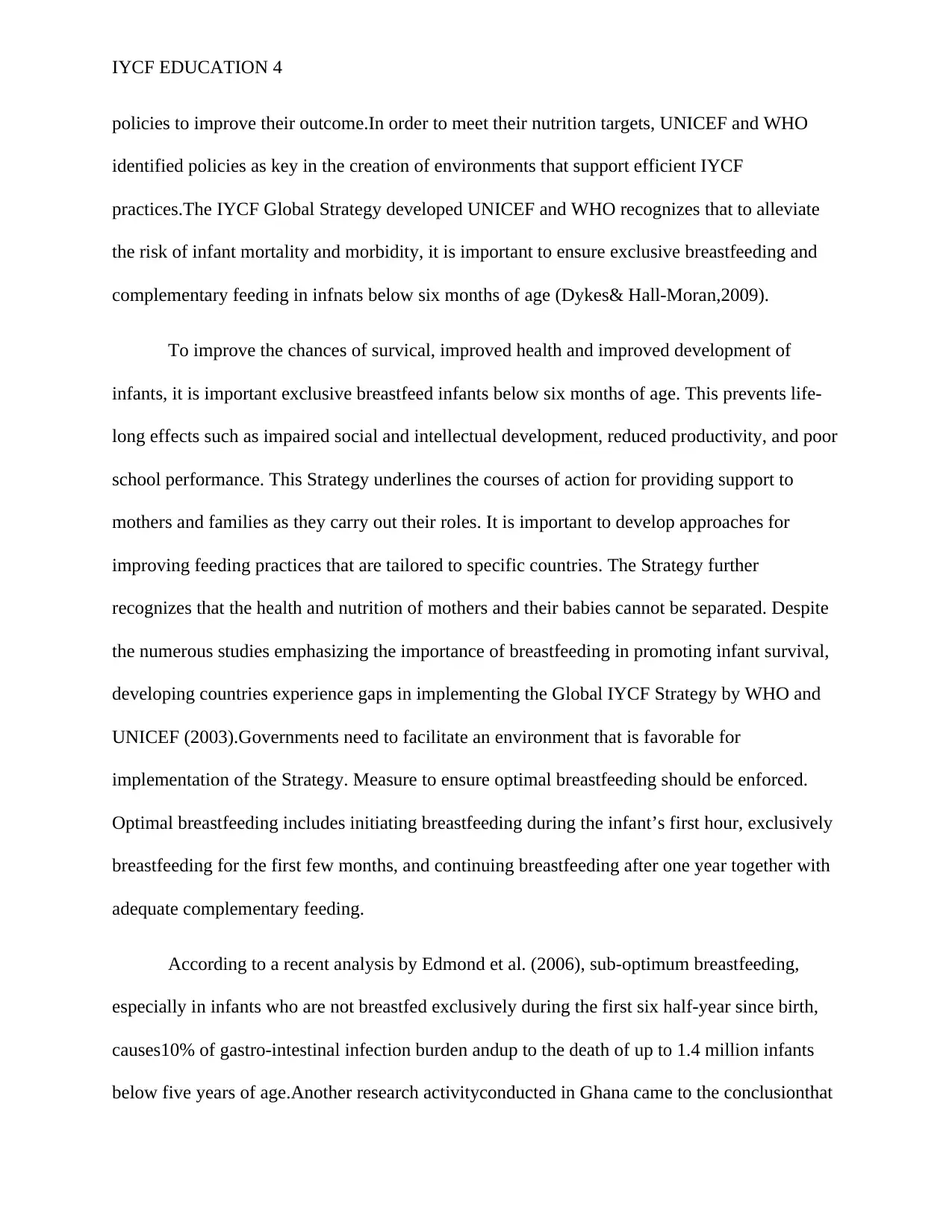
IYCF EDUCATION 4
policies to improve their outcome.In order to meet their nutrition targets, UNICEF and WHO
identified policies as key in the creation of environments that support efficient IYCF
practices.The IYCF Global Strategy developed UNICEF and WHO recognizes that to alleviate
the risk of infant mortality and morbidity, it is important to ensure exclusive breastfeeding and
complementary feeding in infnats below six months of age (Dykes& Hall-Moran,2009).
To improve the chances of survical, improved health and improved development of
infants, it is important exclusive breastfeed infants below six months of age. This prevents life-
long effects such as impaired social and intellectual development, reduced productivity, and poor
school performance. This Strategy underlines the courses of action for providing support to
mothers and families as they carry out their roles. It is important to develop approaches for
improving feeding practices that are tailored to specific countries. The Strategy further
recognizes that the health and nutrition of mothers and their babies cannot be separated. Despite
the numerous studies emphasizing the importance of breastfeeding in promoting infant survival,
developing countries experience gaps in implementing the Global IYCF Strategy by WHO and
UNICEF (2003).Governments need to facilitate an environment that is favorable for
implementation of the Strategy. Measure to ensure optimal breastfeeding should be enforced.
Optimal breastfeeding includes initiating breastfeeding during the infant’s first hour, exclusively
breastfeeding for the first few months, and continuing breastfeeding after one year together with
adequate complementary feeding.
According to a recent analysis by Edmond et al. (2006), sub-optimum breastfeeding,
especially in infants who are not breastfed exclusively during the first six half-year since birth,
causes10% of gastro-intestinal infection burden andup to the death of up to 1.4 million infants
below five years of age.Another research activityconducted in Ghana came to the conclusionthat
policies to improve their outcome.In order to meet their nutrition targets, UNICEF and WHO
identified policies as key in the creation of environments that support efficient IYCF
practices.The IYCF Global Strategy developed UNICEF and WHO recognizes that to alleviate
the risk of infant mortality and morbidity, it is important to ensure exclusive breastfeeding and
complementary feeding in infnats below six months of age (Dykes& Hall-Moran,2009).
To improve the chances of survical, improved health and improved development of
infants, it is important exclusive breastfeed infants below six months of age. This prevents life-
long effects such as impaired social and intellectual development, reduced productivity, and poor
school performance. This Strategy underlines the courses of action for providing support to
mothers and families as they carry out their roles. It is important to develop approaches for
improving feeding practices that are tailored to specific countries. The Strategy further
recognizes that the health and nutrition of mothers and their babies cannot be separated. Despite
the numerous studies emphasizing the importance of breastfeeding in promoting infant survival,
developing countries experience gaps in implementing the Global IYCF Strategy by WHO and
UNICEF (2003).Governments need to facilitate an environment that is favorable for
implementation of the Strategy. Measure to ensure optimal breastfeeding should be enforced.
Optimal breastfeeding includes initiating breastfeeding during the infant’s first hour, exclusively
breastfeeding for the first few months, and continuing breastfeeding after one year together with
adequate complementary feeding.
According to a recent analysis by Edmond et al. (2006), sub-optimum breastfeeding,
especially in infants who are not breastfed exclusively during the first six half-year since birth,
causes10% of gastro-intestinal infection burden andup to the death of up to 1.4 million infants
below five years of age.Another research activityconducted in Ghana came to the conclusionthat
Paraphrase This Document
Need a fresh take? Get an instant paraphrase of this document with our AI Paraphraser
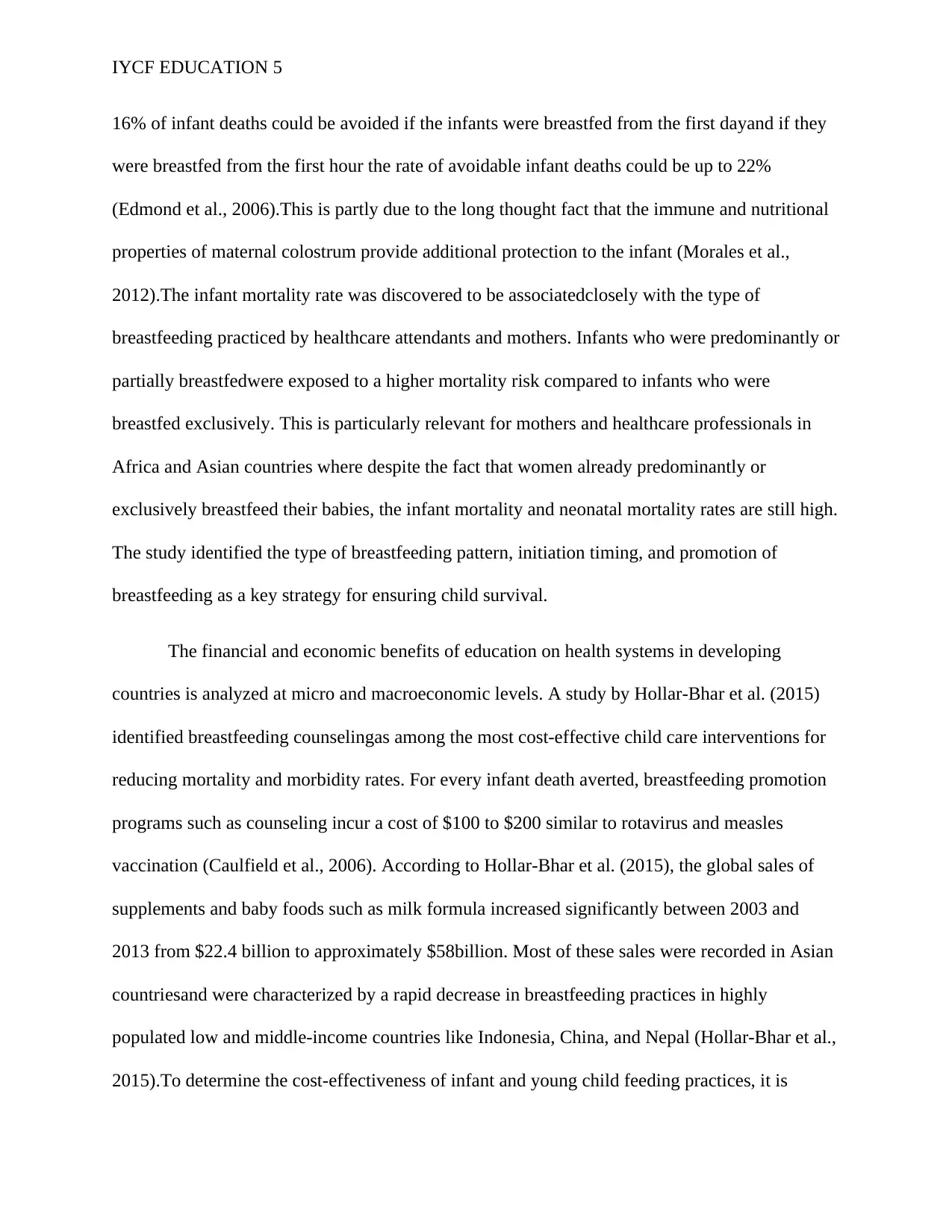
IYCF EDUCATION 5
16% of infant deaths could be avoided if the infants were breastfed from the first dayand if they
were breastfed from the first hour the rate of avoidable infant deaths could be up to 22%
(Edmond et al., 2006).This is partly due to the long thought fact that the immune and nutritional
properties of maternal colostrum provide additional protection to the infant (Morales et al.,
2012).The infant mortality rate was discovered to be associatedclosely with the type of
breastfeeding practiced by healthcare attendants and mothers. Infants who were predominantly or
partially breastfedwere exposed to a higher mortality risk compared to infants who were
breastfed exclusively. This is particularly relevant for mothers and healthcare professionals in
Africa and Asian countries where despite the fact that women already predominantly or
exclusively breastfeed their babies, the infant mortality and neonatal mortality rates are still high.
The study identified the type of breastfeeding pattern, initiation timing, and promotion of
breastfeeding as a key strategy for ensuring child survival.
The financial and economic benefits of education on health systems in developing
countries is analyzed at micro and macroeconomic levels. A study by Hollar-Bhar et al. (2015)
identified breastfeeding counselingas among the most cost-effective child care interventions for
reducing mortality and morbidity rates. For every infant death averted, breastfeeding promotion
programs such as counseling incur a cost of $100 to $200 similar to rotavirus and measles
vaccination (Caulfield et al., 2006). According to Hollar-Bhar et al. (2015), the global sales of
supplements and baby foods such as milk formula increased significantly between 2003 and
2013 from $22.4 billion to approximately $58billion. Most of these sales were recorded in Asian
countriesand were characterized by a rapid decrease in breastfeeding practices in highly
populated low and middle-income countries like Indonesia, China, and Nepal (Hollar-Bhar et al.,
2015).To determine the cost-effectiveness of infant and young child feeding practices, it is
16% of infant deaths could be avoided if the infants were breastfed from the first dayand if they
were breastfed from the first hour the rate of avoidable infant deaths could be up to 22%
(Edmond et al., 2006).This is partly due to the long thought fact that the immune and nutritional
properties of maternal colostrum provide additional protection to the infant (Morales et al.,
2012).The infant mortality rate was discovered to be associatedclosely with the type of
breastfeeding practiced by healthcare attendants and mothers. Infants who were predominantly or
partially breastfedwere exposed to a higher mortality risk compared to infants who were
breastfed exclusively. This is particularly relevant for mothers and healthcare professionals in
Africa and Asian countries where despite the fact that women already predominantly or
exclusively breastfeed their babies, the infant mortality and neonatal mortality rates are still high.
The study identified the type of breastfeeding pattern, initiation timing, and promotion of
breastfeeding as a key strategy for ensuring child survival.
The financial and economic benefits of education on health systems in developing
countries is analyzed at micro and macroeconomic levels. A study by Hollar-Bhar et al. (2015)
identified breastfeeding counselingas among the most cost-effective child care interventions for
reducing mortality and morbidity rates. For every infant death averted, breastfeeding promotion
programs such as counseling incur a cost of $100 to $200 similar to rotavirus and measles
vaccination (Caulfield et al., 2006). According to Hollar-Bhar et al. (2015), the global sales of
supplements and baby foods such as milk formula increased significantly between 2003 and
2013 from $22.4 billion to approximately $58billion. Most of these sales were recorded in Asian
countriesand were characterized by a rapid decrease in breastfeeding practices in highly
populated low and middle-income countries like Indonesia, China, and Nepal (Hollar-Bhar et al.,
2015).To determine the cost-effectiveness of infant and young child feeding practices, it is
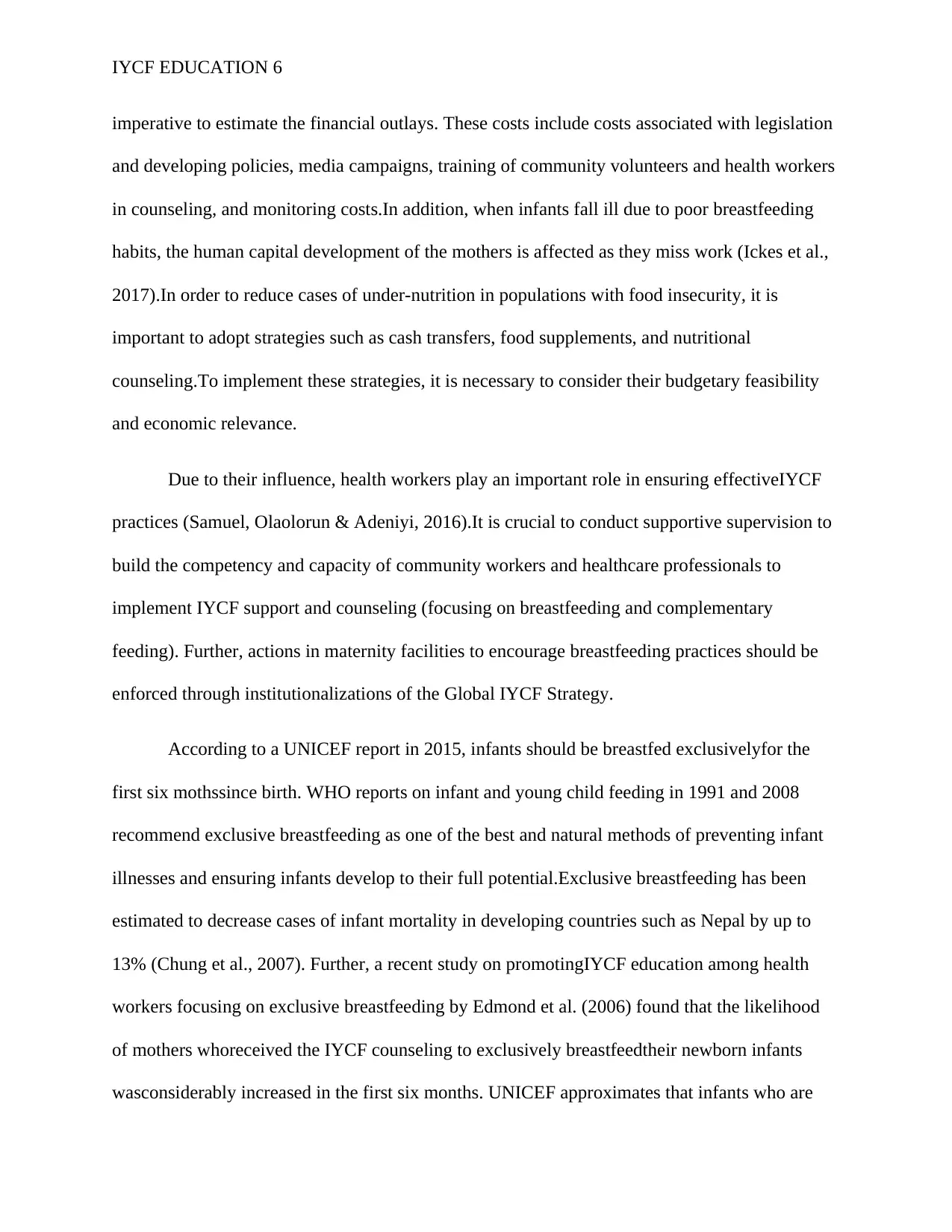
IYCF EDUCATION 6
imperative to estimate the financial outlays. These costs include costs associated with legislation
and developing policies, media campaigns, training of community volunteers and health workers
in counseling, and monitoring costs.In addition, when infants fall ill due to poor breastfeeding
habits, the human capital development of the mothers is affected as they miss work (Ickes et al.,
2017).In order to reduce cases of under-nutrition in populations with food insecurity, it is
important to adopt strategies such as cash transfers, food supplements, and nutritional
counseling.To implement these strategies, it is necessary to consider their budgetary feasibility
and economic relevance.
Due to their influence, health workers play an important role in ensuring effectiveIYCF
practices (Samuel, Olaolorun & Adeniyi, 2016).It is crucial to conduct supportive supervision to
build the competency and capacity of community workers and healthcare professionals to
implement IYCF support and counseling (focusing on breastfeeding and complementary
feeding). Further, actions in maternity facilities to encourage breastfeeding practices should be
enforced through institutionalizations of the Global IYCF Strategy.
According to a UNICEF report in 2015, infants should be breastfed exclusivelyfor the
first six mothssince birth. WHO reports on infant and young child feeding in 1991 and 2008
recommend exclusive breastfeeding as one of the best and natural methods of preventing infant
illnesses and ensuring infants develop to their full potential.Exclusive breastfeeding has been
estimated to decrease cases of infant mortality in developing countries such as Nepal by up to
13% (Chung et al., 2007). Further, a recent study on promotingIYCF education among health
workers focusing on exclusive breastfeeding by Edmond et al. (2006) found that the likelihood
of mothers whoreceived the IYCF counseling to exclusively breastfeedtheir newborn infants
wasconsiderably increased in the first six months. UNICEF approximates that infants who are
imperative to estimate the financial outlays. These costs include costs associated with legislation
and developing policies, media campaigns, training of community volunteers and health workers
in counseling, and monitoring costs.In addition, when infants fall ill due to poor breastfeeding
habits, the human capital development of the mothers is affected as they miss work (Ickes et al.,
2017).In order to reduce cases of under-nutrition in populations with food insecurity, it is
important to adopt strategies such as cash transfers, food supplements, and nutritional
counseling.To implement these strategies, it is necessary to consider their budgetary feasibility
and economic relevance.
Due to their influence, health workers play an important role in ensuring effectiveIYCF
practices (Samuel, Olaolorun & Adeniyi, 2016).It is crucial to conduct supportive supervision to
build the competency and capacity of community workers and healthcare professionals to
implement IYCF support and counseling (focusing on breastfeeding and complementary
feeding). Further, actions in maternity facilities to encourage breastfeeding practices should be
enforced through institutionalizations of the Global IYCF Strategy.
According to a UNICEF report in 2015, infants should be breastfed exclusivelyfor the
first six mothssince birth. WHO reports on infant and young child feeding in 1991 and 2008
recommend exclusive breastfeeding as one of the best and natural methods of preventing infant
illnesses and ensuring infants develop to their full potential.Exclusive breastfeeding has been
estimated to decrease cases of infant mortality in developing countries such as Nepal by up to
13% (Chung et al., 2007). Further, a recent study on promotingIYCF education among health
workers focusing on exclusive breastfeeding by Edmond et al. (2006) found that the likelihood
of mothers whoreceived the IYCF counseling to exclusively breastfeedtheir newborn infants
wasconsiderably increased in the first six months. UNICEF approximates that infants who are
⊘ This is a preview!⊘
Do you want full access?
Subscribe today to unlock all pages.

Trusted by 1+ million students worldwide
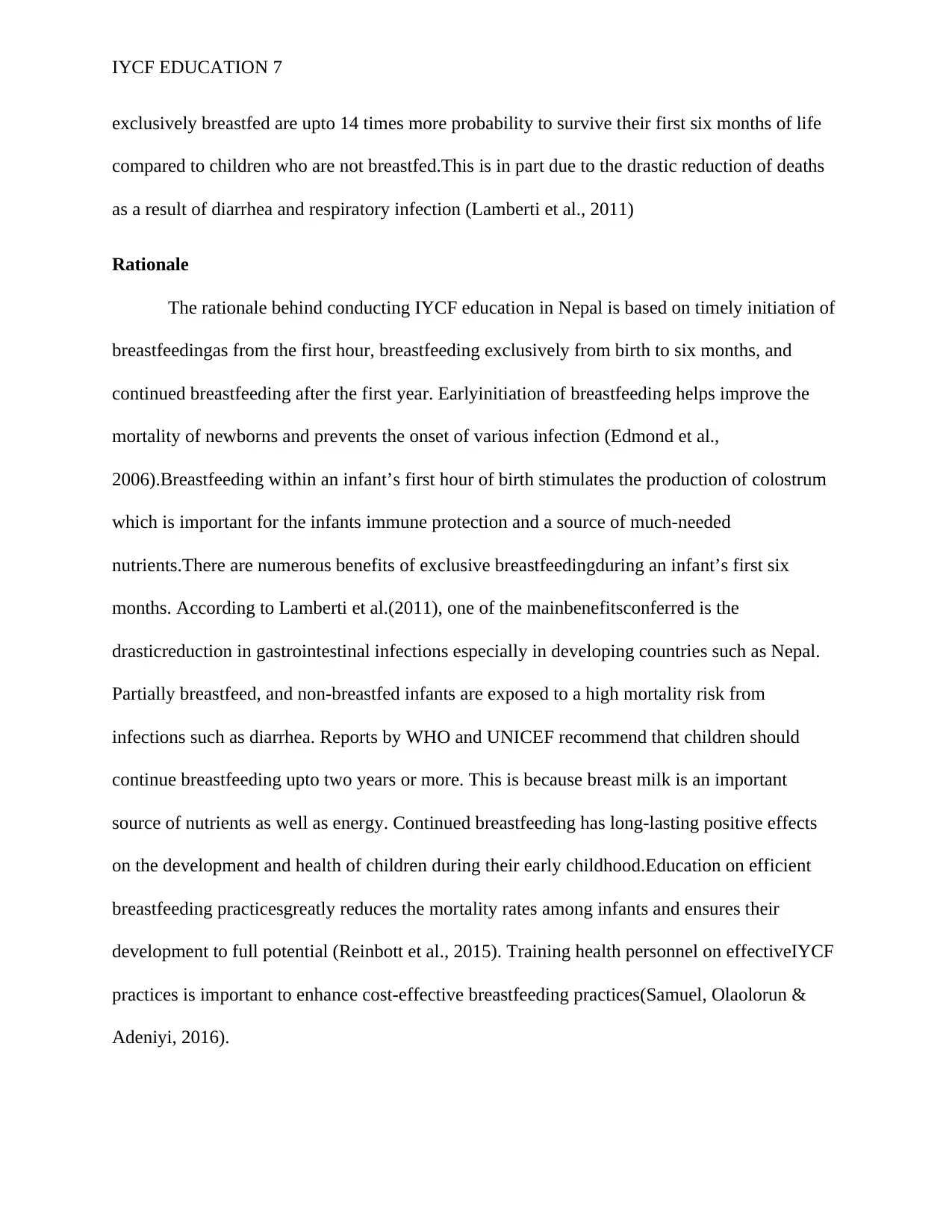
IYCF EDUCATION 7
exclusively breastfed are upto 14 times more probability to survive their first six months of life
compared to children who are not breastfed.This is in part due to the drastic reduction of deaths
as a result of diarrhea and respiratory infection (Lamberti et al., 2011)
Rationale
The rationale behind conducting IYCF education in Nepal is based on timely initiation of
breastfeedingas from the first hour, breastfeeding exclusively from birth to six months, and
continued breastfeeding after the first year. Earlyinitiation of breastfeeding helps improve the
mortality of newborns and prevents the onset of various infection (Edmond et al.,
2006).Breastfeeding within an infant’s first hour of birth stimulates the production of colostrum
which is important for the infants immune protection and a source of much-needed
nutrients.There are numerous benefits of exclusive breastfeedingduring an infant’s first six
months. According to Lamberti et al.(2011), one of the mainbenefitsconferred is the
drasticreduction in gastrointestinal infections especially in developing countries such as Nepal.
Partially breastfeed, and non-breastfed infants are exposed to a high mortality risk from
infections such as diarrhea. Reports by WHO and UNICEF recommend that children should
continue breastfeeding upto two years or more. This is because breast milk is an important
source of nutrients as well as energy. Continued breastfeeding has long-lasting positive effects
on the development and health of children during their early childhood.Education on efficient
breastfeeding practicesgreatly reduces the mortality rates among infants and ensures their
development to full potential (Reinbott et al., 2015). Training health personnel on effectiveIYCF
practices is important to enhance cost-effective breastfeeding practices(Samuel, Olaolorun &
Adeniyi, 2016).
exclusively breastfed are upto 14 times more probability to survive their first six months of life
compared to children who are not breastfed.This is in part due to the drastic reduction of deaths
as a result of diarrhea and respiratory infection (Lamberti et al., 2011)
Rationale
The rationale behind conducting IYCF education in Nepal is based on timely initiation of
breastfeedingas from the first hour, breastfeeding exclusively from birth to six months, and
continued breastfeeding after the first year. Earlyinitiation of breastfeeding helps improve the
mortality of newborns and prevents the onset of various infection (Edmond et al.,
2006).Breastfeeding within an infant’s first hour of birth stimulates the production of colostrum
which is important for the infants immune protection and a source of much-needed
nutrients.There are numerous benefits of exclusive breastfeedingduring an infant’s first six
months. According to Lamberti et al.(2011), one of the mainbenefitsconferred is the
drasticreduction in gastrointestinal infections especially in developing countries such as Nepal.
Partially breastfeed, and non-breastfed infants are exposed to a high mortality risk from
infections such as diarrhea. Reports by WHO and UNICEF recommend that children should
continue breastfeeding upto two years or more. This is because breast milk is an important
source of nutrients as well as energy. Continued breastfeeding has long-lasting positive effects
on the development and health of children during their early childhood.Education on efficient
breastfeeding practicesgreatly reduces the mortality rates among infants and ensures their
development to full potential (Reinbott et al., 2015). Training health personnel on effectiveIYCF
practices is important to enhance cost-effective breastfeeding practices(Samuel, Olaolorun &
Adeniyi, 2016).
Paraphrase This Document
Need a fresh take? Get an instant paraphrase of this document with our AI Paraphraser
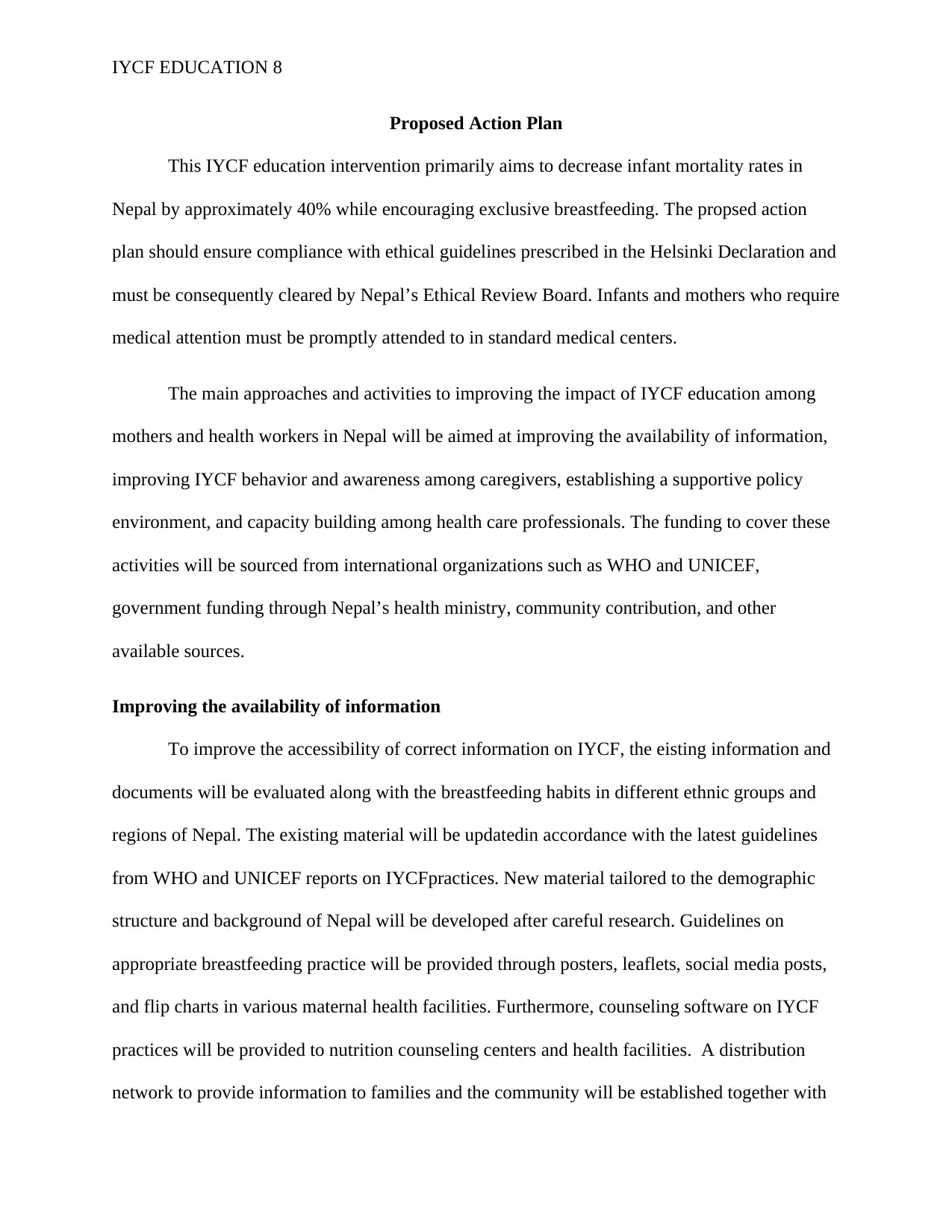
IYCF EDUCATION 8
Proposed Action Plan
This IYCF education intervention primarily aims to decrease infant mortality rates in
Nepal by approximately 40% while encouraging exclusive breastfeeding. The propsed action
plan should ensure compliance with ethical guidelines prescribed in the Helsinki Declaration and
must be consequently cleared by Nepal’s Ethical Review Board. Infants and mothers who require
medical attention must be promptly attended to in standard medical centers.
The main approaches and activities to improving the impact of IYCF education among
mothers and health workers in Nepal will be aimed at improving the availability of information,
improving IYCF behavior and awareness among caregivers, establishing a supportive policy
environment, and capacity building among health care professionals. The funding to cover these
activities will be sourced from international organizations such as WHO and UNICEF,
government funding through Nepal’s health ministry, community contribution, and other
available sources.
Improving the availability of information
To improve the accessibility of correct information on IYCF, the eisting information and
documents will be evaluated along with the breastfeeding habits in different ethnic groups and
regions of Nepal. The existing material will be updatedin accordance with the latest guidelines
from WHO and UNICEF reports on IYCFpractices. New material tailored to the demographic
structure and background of Nepal will be developed after careful research. Guidelines on
appropriate breastfeeding practice will be provided through posters, leaflets, social media posts,
and flip charts in various maternal health facilities. Furthermore, counseling software on IYCF
practices will be provided to nutrition counseling centers and health facilities. A distribution
network to provide information to families and the community will be established together with
Proposed Action Plan
This IYCF education intervention primarily aims to decrease infant mortality rates in
Nepal by approximately 40% while encouraging exclusive breastfeeding. The propsed action
plan should ensure compliance with ethical guidelines prescribed in the Helsinki Declaration and
must be consequently cleared by Nepal’s Ethical Review Board. Infants and mothers who require
medical attention must be promptly attended to in standard medical centers.
The main approaches and activities to improving the impact of IYCF education among
mothers and health workers in Nepal will be aimed at improving the availability of information,
improving IYCF behavior and awareness among caregivers, establishing a supportive policy
environment, and capacity building among health care professionals. The funding to cover these
activities will be sourced from international organizations such as WHO and UNICEF,
government funding through Nepal’s health ministry, community contribution, and other
available sources.
Improving the availability of information
To improve the accessibility of correct information on IYCF, the eisting information and
documents will be evaluated along with the breastfeeding habits in different ethnic groups and
regions of Nepal. The existing material will be updatedin accordance with the latest guidelines
from WHO and UNICEF reports on IYCFpractices. New material tailored to the demographic
structure and background of Nepal will be developed after careful research. Guidelines on
appropriate breastfeeding practice will be provided through posters, leaflets, social media posts,
and flip charts in various maternal health facilities. Furthermore, counseling software on IYCF
practices will be provided to nutrition counseling centers and health facilities. A distribution
network to provide information to families and the community will be established together with
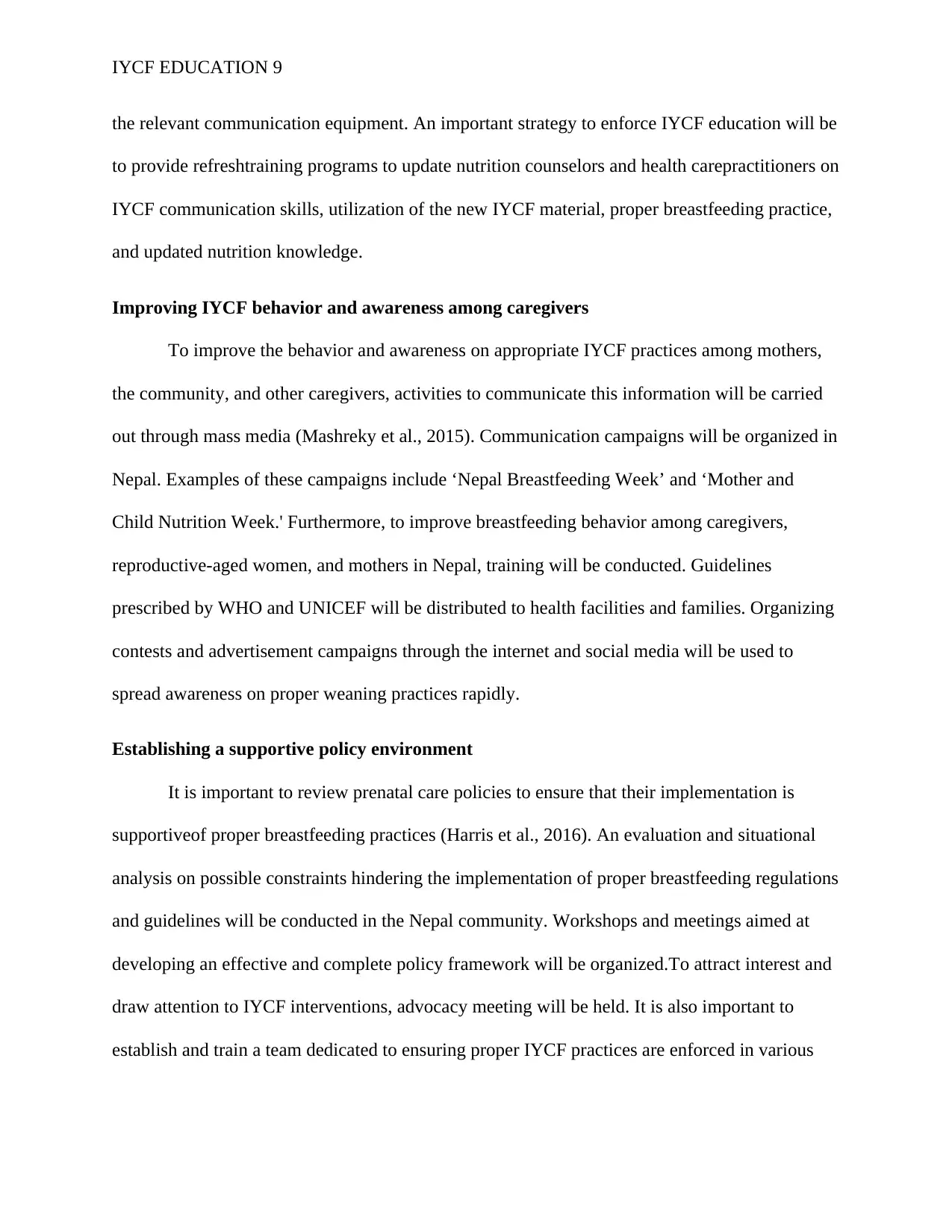
IYCF EDUCATION 9
the relevant communication equipment. An important strategy to enforce IYCF education will be
to provide refreshtraining programs to update nutrition counselors and health carepractitioners on
IYCF communication skills, utilization of the new IYCF material, proper breastfeeding practice,
and updated nutrition knowledge.
Improving IYCF behavior and awareness among caregivers
To improve the behavior and awareness on appropriate IYCF practices among mothers,
the community, and other caregivers, activities to communicate this information will be carried
out through mass media (Mashreky et al., 2015). Communication campaigns will be organized in
Nepal. Examples of these campaigns include ‘Nepal Breastfeeding Week’ and ‘Mother and
Child Nutrition Week.' Furthermore, to improve breastfeeding behavior among caregivers,
reproductive-aged women, and mothers in Nepal, training will be conducted. Guidelines
prescribed by WHO and UNICEF will be distributed to health facilities and families. Organizing
contests and advertisement campaigns through the internet and social media will be used to
spread awareness on proper weaning practices rapidly.
Establishing a supportive policy environment
It is important to review prenatal care policies to ensure that their implementation is
supportiveof proper breastfeeding practices (Harris et al., 2016). An evaluation and situational
analysis on possible constraints hindering the implementation of proper breastfeeding regulations
and guidelines will be conducted in the Nepal community. Workshops and meetings aimed at
developing an effective and complete policy framework will be organized.To attract interest and
draw attention to IYCF interventions, advocacy meeting will be held. It is also important to
establish and train a team dedicated to ensuring proper IYCF practices are enforced in various
the relevant communication equipment. An important strategy to enforce IYCF education will be
to provide refreshtraining programs to update nutrition counselors and health carepractitioners on
IYCF communication skills, utilization of the new IYCF material, proper breastfeeding practice,
and updated nutrition knowledge.
Improving IYCF behavior and awareness among caregivers
To improve the behavior and awareness on appropriate IYCF practices among mothers,
the community, and other caregivers, activities to communicate this information will be carried
out through mass media (Mashreky et al., 2015). Communication campaigns will be organized in
Nepal. Examples of these campaigns include ‘Nepal Breastfeeding Week’ and ‘Mother and
Child Nutrition Week.' Furthermore, to improve breastfeeding behavior among caregivers,
reproductive-aged women, and mothers in Nepal, training will be conducted. Guidelines
prescribed by WHO and UNICEF will be distributed to health facilities and families. Organizing
contests and advertisement campaigns through the internet and social media will be used to
spread awareness on proper weaning practices rapidly.
Establishing a supportive policy environment
It is important to review prenatal care policies to ensure that their implementation is
supportiveof proper breastfeeding practices (Harris et al., 2016). An evaluation and situational
analysis on possible constraints hindering the implementation of proper breastfeeding regulations
and guidelines will be conducted in the Nepal community. Workshops and meetings aimed at
developing an effective and complete policy framework will be organized.To attract interest and
draw attention to IYCF interventions, advocacy meeting will be held. It is also important to
establish and train a team dedicated to ensuring proper IYCF practices are enforced in various
⊘ This is a preview!⊘
Do you want full access?
Subscribe today to unlock all pages.

Trusted by 1+ million students worldwide
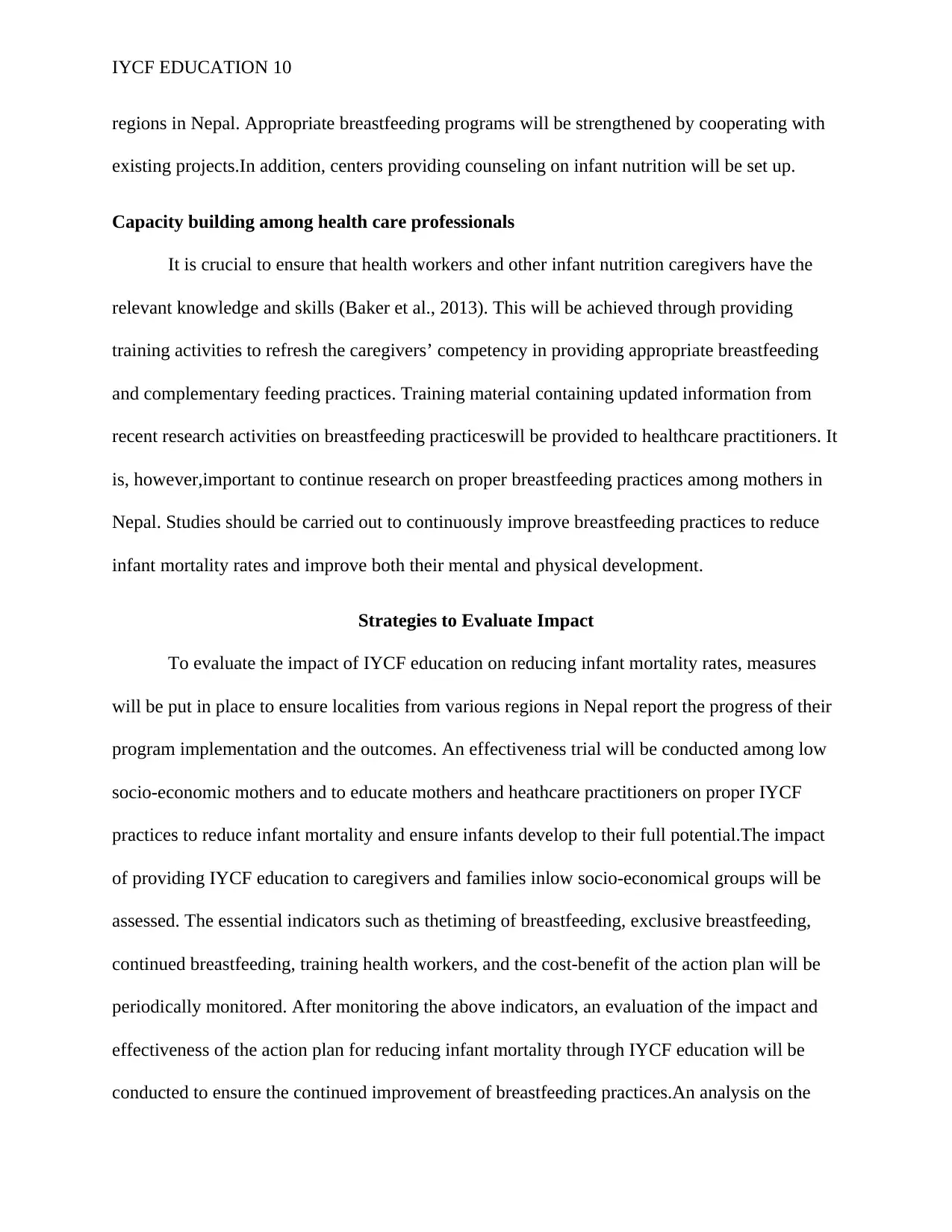
IYCF EDUCATION 10
regions in Nepal. Appropriate breastfeeding programs will be strengthened by cooperating with
existing projects.In addition, centers providing counseling on infant nutrition will be set up.
Capacity building among health care professionals
It is crucial to ensure that health workers and other infant nutrition caregivers have the
relevant knowledge and skills (Baker et al., 2013). This will be achieved through providing
training activities to refresh the caregivers’ competency in providing appropriate breastfeeding
and complementary feeding practices. Training material containing updated information from
recent research activities on breastfeeding practiceswill be provided to healthcare practitioners. It
is, however,important to continue research on proper breastfeeding practices among mothers in
Nepal. Studies should be carried out to continuously improve breastfeeding practices to reduce
infant mortality rates and improve both their mental and physical development.
Strategies to Evaluate Impact
To evaluate the impact of IYCF education on reducing infant mortality rates, measures
will be put in place to ensure localities from various regions in Nepal report the progress of their
program implementation and the outcomes. An effectiveness trial will be conducted among low
socio-economic mothers and to educate mothers and heathcare practitioners on proper IYCF
practices to reduce infant mortality and ensure infants develop to their full potential.The impact
of providing IYCF education to caregivers and families inlow socio-economical groups will be
assessed. The essential indicators such as thetiming of breastfeeding, exclusive breastfeeding,
continued breastfeeding, training health workers, and the cost-benefit of the action plan will be
periodically monitored. After monitoring the above indicators, an evaluation of the impact and
effectiveness of the action plan for reducing infant mortality through IYCF education will be
conducted to ensure the continued improvement of breastfeeding practices.An analysis on the
regions in Nepal. Appropriate breastfeeding programs will be strengthened by cooperating with
existing projects.In addition, centers providing counseling on infant nutrition will be set up.
Capacity building among health care professionals
It is crucial to ensure that health workers and other infant nutrition caregivers have the
relevant knowledge and skills (Baker et al., 2013). This will be achieved through providing
training activities to refresh the caregivers’ competency in providing appropriate breastfeeding
and complementary feeding practices. Training material containing updated information from
recent research activities on breastfeeding practiceswill be provided to healthcare practitioners. It
is, however,important to continue research on proper breastfeeding practices among mothers in
Nepal. Studies should be carried out to continuously improve breastfeeding practices to reduce
infant mortality rates and improve both their mental and physical development.
Strategies to Evaluate Impact
To evaluate the impact of IYCF education on reducing infant mortality rates, measures
will be put in place to ensure localities from various regions in Nepal report the progress of their
program implementation and the outcomes. An effectiveness trial will be conducted among low
socio-economic mothers and to educate mothers and heathcare practitioners on proper IYCF
practices to reduce infant mortality and ensure infants develop to their full potential.The impact
of providing IYCF education to caregivers and families inlow socio-economical groups will be
assessed. The essential indicators such as thetiming of breastfeeding, exclusive breastfeeding,
continued breastfeeding, training health workers, and the cost-benefit of the action plan will be
periodically monitored. After monitoring the above indicators, an evaluation of the impact and
effectiveness of the action plan for reducing infant mortality through IYCF education will be
conducted to ensure the continued improvement of breastfeeding practices.An analysis on the
Paraphrase This Document
Need a fresh take? Get an instant paraphrase of this document with our AI Paraphraser
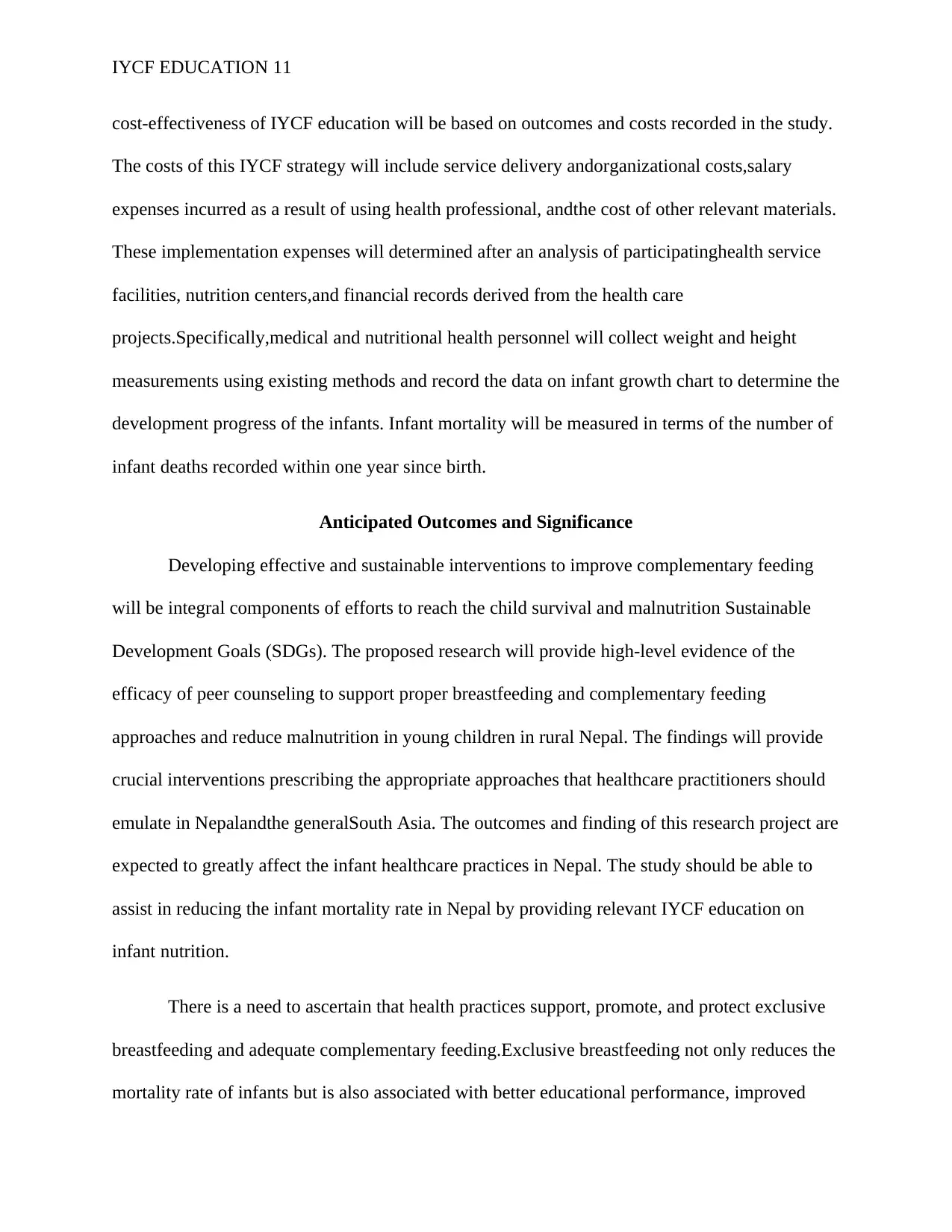
IYCF EDUCATION 11
cost-effectiveness of IYCF education will be based on outcomes and costs recorded in the study.
The costs of this IYCF strategy will include service delivery andorganizational costs,salary
expenses incurred as a result of using health professional, andthe cost of other relevant materials.
These implementation expenses will determined after an analysis of participatinghealth service
facilities, nutrition centers,and financial records derived from the health care
projects.Specifically,medical and nutritional health personnel will collect weight and height
measurements using existing methods and record the data on infant growth chart to determine the
development progress of the infants. Infant mortality will be measured in terms of the number of
infant deaths recorded within one year since birth.
Anticipated Outcomes and Significance
Developing effective and sustainable interventions to improve complementary feeding
will be integral components of efforts to reach the child survival and malnutrition Sustainable
Development Goals (SDGs). The proposed research will provide high-level evidence of the
efficacy of peer counseling to support proper breastfeeding and complementary feeding
approaches and reduce malnutrition in young children in rural Nepal. The findings will provide
crucial interventions prescribing the appropriate approaches that healthcare practitioners should
emulate in Nepalandthe generalSouth Asia. The outcomes and finding of this research project are
expected to greatly affect the infant healthcare practices in Nepal. The study should be able to
assist in reducing the infant mortality rate in Nepal by providing relevant IYCF education on
infant nutrition.
There is a need to ascertain that health practices support, promote, and protect exclusive
breastfeeding and adequate complementary feeding.Exclusive breastfeeding not only reduces the
mortality rate of infants but is also associated with better educational performance, improved
cost-effectiveness of IYCF education will be based on outcomes and costs recorded in the study.
The costs of this IYCF strategy will include service delivery andorganizational costs,salary
expenses incurred as a result of using health professional, andthe cost of other relevant materials.
These implementation expenses will determined after an analysis of participatinghealth service
facilities, nutrition centers,and financial records derived from the health care
projects.Specifically,medical and nutritional health personnel will collect weight and height
measurements using existing methods and record the data on infant growth chart to determine the
development progress of the infants. Infant mortality will be measured in terms of the number of
infant deaths recorded within one year since birth.
Anticipated Outcomes and Significance
Developing effective and sustainable interventions to improve complementary feeding
will be integral components of efforts to reach the child survival and malnutrition Sustainable
Development Goals (SDGs). The proposed research will provide high-level evidence of the
efficacy of peer counseling to support proper breastfeeding and complementary feeding
approaches and reduce malnutrition in young children in rural Nepal. The findings will provide
crucial interventions prescribing the appropriate approaches that healthcare practitioners should
emulate in Nepalandthe generalSouth Asia. The outcomes and finding of this research project are
expected to greatly affect the infant healthcare practices in Nepal. The study should be able to
assist in reducing the infant mortality rate in Nepal by providing relevant IYCF education on
infant nutrition.
There is a need to ascertain that health practices support, promote, and protect exclusive
breastfeeding and adequate complementary feeding.Exclusive breastfeeding not only reduces the
mortality rate of infants but is also associated with better educational performance, improved
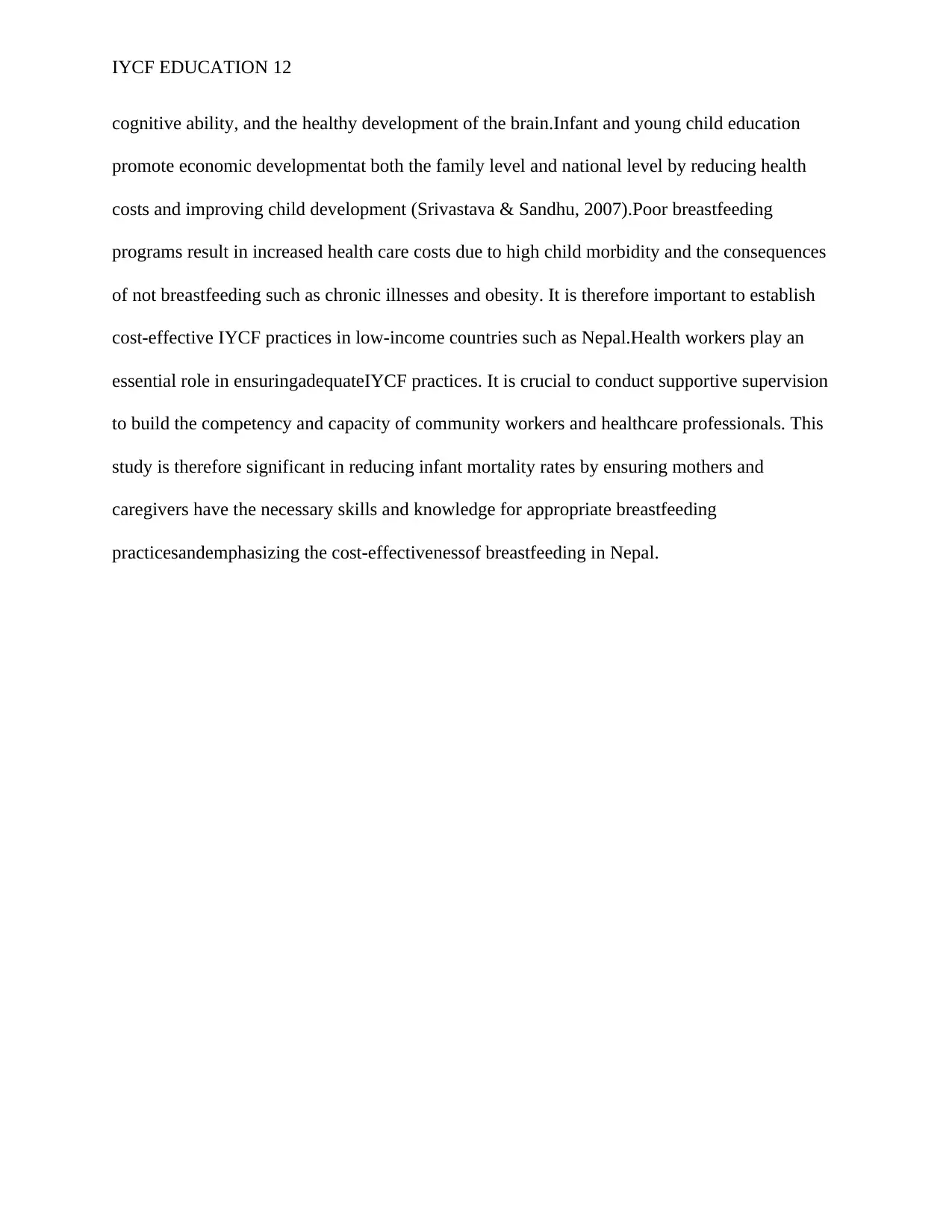
IYCF EDUCATION 12
cognitive ability, and the healthy development of the brain.Infant and young child education
promote economic developmentat both the family level and national level by reducing health
costs and improving child development (Srivastava & Sandhu, 2007).Poor breastfeeding
programs result in increased health care costs due to high child morbidity and the consequences
of not breastfeeding such as chronic illnesses and obesity. It is therefore important to establish
cost-effective IYCF practices in low-income countries such as Nepal.Health workers play an
essential role in ensuringadequateIYCF practices. It is crucial to conduct supportive supervision
to build the competency and capacity of community workers and healthcare professionals. This
study is therefore significant in reducing infant mortality rates by ensuring mothers and
caregivers have the necessary skills and knowledge for appropriate breastfeeding
practicesandemphasizing the cost-effectivenessof breastfeeding in Nepal.
cognitive ability, and the healthy development of the brain.Infant and young child education
promote economic developmentat both the family level and national level by reducing health
costs and improving child development (Srivastava & Sandhu, 2007).Poor breastfeeding
programs result in increased health care costs due to high child morbidity and the consequences
of not breastfeeding such as chronic illnesses and obesity. It is therefore important to establish
cost-effective IYCF practices in low-income countries such as Nepal.Health workers play an
essential role in ensuringadequateIYCF practices. It is crucial to conduct supportive supervision
to build the competency and capacity of community workers and healthcare professionals. This
study is therefore significant in reducing infant mortality rates by ensuring mothers and
caregivers have the necessary skills and knowledge for appropriate breastfeeding
practicesandemphasizing the cost-effectivenessof breastfeeding in Nepal.
⊘ This is a preview!⊘
Do you want full access?
Subscribe today to unlock all pages.

Trusted by 1+ million students worldwide
1 out of 18
Related Documents
Your All-in-One AI-Powered Toolkit for Academic Success.
+13062052269
info@desklib.com
Available 24*7 on WhatsApp / Email
![[object Object]](/_next/static/media/star-bottom.7253800d.svg)
Unlock your academic potential
Copyright © 2020–2025 A2Z Services. All Rights Reserved. Developed and managed by ZUCOL.





